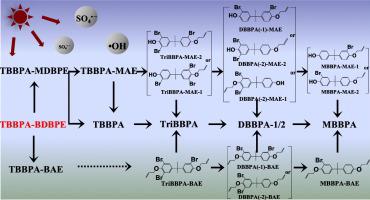Science of the Total Environment ( IF 8.2 ) Pub Date : 2023-05-20 , DOI: 10.1016/j.scitotenv.2023.164227
Yuqing Jiang 1 , Ling Wang 1 , Minggang Zheng 2 , Yongfeng Lin 3 , Aifeng Liu 1 , Yawei Wang 4 , Ying Li 1

|
The transformation products and mechanism of tetrabromobisphenol A (TBBPA) derivatives are still largely unknown compared with TBBPA. In this paper, sediment, soil and water samples (15 sites, 45 samples) collected in a river flowing through brominated flame retardant manufacturing zone were analyzed to determine TBBPA derivatives, byproducts, and transformation products. TBBPA derivatives and byproducts were detected with concentrations ranging from none detection to 1.1 × 104 ng/g dw and with detection frequencies of 0–100 % in all samples. The concentrations of TBBPA derivatives such as TBBPA bis(2,3-dibromopropyl) ether (TBBPA-BDBPE) and TBBPA bis(allyl ether) in sediment and soil samples were higher than that of TBBPA. In addition, the occurrence of various unknown bromobisphenol A allyl ether analogs in the samples was further confirmed by using 11 synthesized analogs, which might be produced during the waste treatment process of the factories. The possible transformation pathways of TBBPA-BDBPE were revealed for the first time by using UV/base/persulfate (PS) as designed photooxidation waste treatment system in the laboratory. Ether bond cleavage, debromination, and β-scission contributed to the transformation of TBBPA-BDBPE and the occurrence of transformation products in the environment. The concentrations of the transformation products of TBBPA-BDBPE ranged from none detection to 3.4 × 102 ng/g dw. These data provide new insights into the fate of TBBPA derivatives in environmental compartments.
中文翻译:

鉴定低溴双酚A类似物为四溴双酚A双(2,3-二溴丙基)醚(TBBPA-BDBPE)的光氧化产物
与TBBPA相比,四溴双酚A(TBBPA)衍生物的转化产物和机理仍然很大程度上未知。本文对流经溴化阻燃剂生产区的河流中采集的沉积物、土壤和水样(15 个地点,45 个样品)进行了分析,以确定 TBBPA 衍生物、副产物和转化产物。检测到 TBBPA 衍生物和副产物,浓度范围从未检测到 1.1 × 10 4 ng/g dw,所有样品的检测频率为 0–100%。沉积物和土壤样品中TBBPA衍生物如TBBPA双(2,3-二溴丙基)醚(TBBPA-BDBPE)和TBBPA双(烯丙醚)的浓度高于TBBPA。此外,通过11种合成的类似物进一步证实样品中存在多种未知的溴双酚A烯丙基醚类似物,这些类似物可能是在工厂废物处理过程中产生的。通过在实验室中使用UV/碱/过硫酸盐(PS)设计的光氧化废物处理系统,首次揭示了TBBPA-BDBPE可能的转化途径。醚键断裂、脱溴和β-断裂促进了TBBPA-BDBPE的转化以及环境中转化产物的出现。TBBPA-BDBPE的转化产物的浓度范围从未检测到到3.4×10 2 ng/g dw。这些数据为了解 TBBPA 衍生物在环境区划中的命运提供了新的见解。































 京公网安备 11010802027423号
京公网安备 11010802027423号